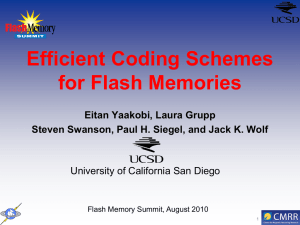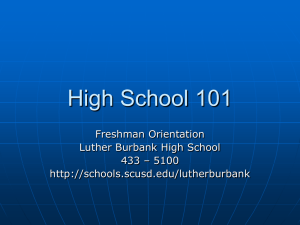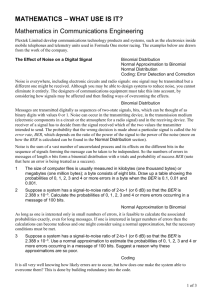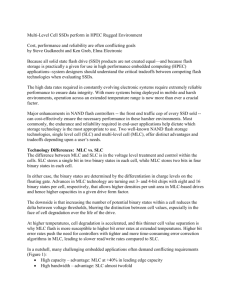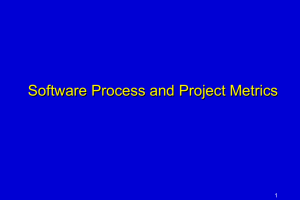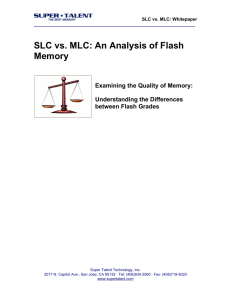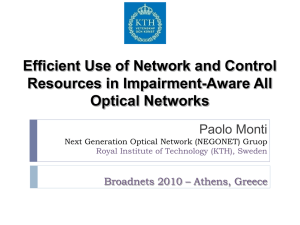flash_coding_NVMW10
advertisement
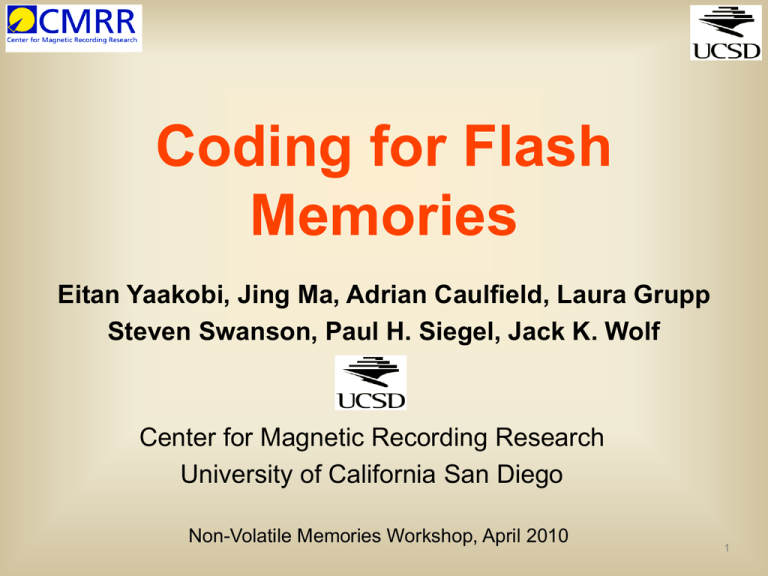
Coding for Flash
Memories
Eitan Yaakobi, Jing Ma, Adrian Caulfield, Laura Grupp
Steven Swanson, Paul H. Siegel, Jack K. Wolf
Center for Magnetic Recording Research
University of California San Diego
Non-Volatile Memories Workshop, April 2010
1
Outline
• Error Characterization of Flash Memories
• Implementing WOM-codes in SLC Flash
• WOM-codes with Better Rates
2
Experiment Description
• We checked several flash memory blocks - SLC and MLC
• For each block the following steps are repeated
• The block is erased
• A pseudo-random data is written to the block
• The data is read and compared to find errors
• Two runs are chosen as representatives for SLC and MLC
• SLC - Collected Iterations: 3,615,224
• MLC - Collected Iterations: 1,054,031
• Remarks:
• We measured many more iterations than the manufacturer’s
guaranteed number of erasures
• The experiment was done in a lab conditions and related factors such
as temperature change, intervals between erasure or multiple
readings before erasures were not considered
3
Raw BER for SLC block
10-4
The BER for each
iteration is measured
We average for every 200
consecutive iterations
Guaranteed lifetime
by the manufacturer
106
4
Raw BER for MLC block
10-3
The BER for each
iteration is measured
We average for every 50
consecutive iterations
Guaranteed lifetime
by the manufacturer
105
5
Basic Error Characteristic
• Directional Errors - Number of Plus errors Vs. Minus errors
• Plus error: Cell in state ‘0’ changes to state ‘1’
• Minus error: Cell in state ‘1’ changes to state ‘0’
• We check the distribution of the errors between plus and minus
errors and the numbers are the same even for individual bits
• Conclusion: There is no preference to correct more plus than
minus errors (or vice versa)
• Burst behavior
• Check how close the errors are to each other
• Explore the potential (dis)advantage of using a RS code VS a
BCH code
• Conclusion: The errors are random and do not have burst
pattern behavior
6
BER Page Dependency
• We checked the BER for each page independently
• SLC block cells layout:
32x215 cells; each page has 214 cells
page 1
page 2
page 3
page 4
page 5
page 6
.
.
.
.
.
.
page 63
page 64
7
BER per page for SLC block
10-3
Red plots – odd pages
The odd pages
have higher BER
Blue plots – even pages
106
8
BER Page Dependency for MLC
• The Most Significant Bit (MSB) and Least Significant Bit
(LSB) represented by one cell belong to two different pages
• Pages storing the LSB are less protected from errors
High Voltage
High Voltage
1,0
1
Trapped
Charge
1 Bit Per Cell
2 States
Trapped
Charge
0
Low Voltage
Single Level Cell (SLC)
2 Bits Per Cell
4 States
1,1
0,1
0,0
Low Voltage
Multi Level Cell (MLC)
9
BER Page Dependency for MLC
A possible MLC block cell layout:
Row
index
LSB of first
214 cells
MSB of first
214 cells
LSB of last
214 cells
MSB of last
214 cells
1
page 1
page 5
page 2
page 6
2
page 3
page 9
page 4
page 10
3
page 7
page 13
page 8
page 14
4
page 11
page 17
page 12
page 18
5
page 15
page 21
page 16
page 22
31
page 119
page 125
page 120
page 126
32
page 123
page 127
page 124
page 128
10
BER per page for MLC block
10-3
Pages, colored the
same, behave similarly
105
11
Bit Error Map in SLC
• We checked how the errors behave for every bit
• For a small window of iterations, 1.5-1.6106
iterations - the BER is roughly fixed, we checked
for each bit the number of times it was in error
12
Bit Error Map for Odd Pages in SLC
104
Calculate the number of times
each bit is in error
Errors are clustered in
columns rather than rows
104
13
Bit Error Map for Odd Pages in MLC
There are less errors since
the BER of the right part is
less than the BER of the left
part
We saw also data
dependency more in the
columns than the rows
104
14
More Work
• We compared between BCH codes, RS
codes, and burst correcting codes
• We evaluated another ECC scheme that
works in two levels:
• First level: ECC for each page
• Second level: ECC for the entire block
15
Write Once Memories (WOM)
• Introduced by Rivest and Shamir, “How to reuse a writeonce memory”, 1982
• The memory elements represent bits (2 levels) and can be
irreversibly programmed from the ‘0’ state to the ‘1’ state
• The problem:
What is the required minimum number of cells, w, to write k
bits t times?
• In order to store k bits twice (t = 2) at least ~1.29k cells are required
• A simple construction achieves 1.5k cells
• Alternatively, it is possible to ask: what is the maximum
total number of bits that can be written using n cells and t
writes?
16
Write Once Memory (WOM)
Codes for SLC
• A scheme for storing two bits twice using only
three cells before erasing the cells
• The cells only increase their level
• How to implement? (in SLC block)
•
•
•
•
Each page stores 2KB/1.5 = 4/3KB per write
A page can be written twice before erasing
Pages are encoded using the WOM code
When the block has to be rewritten, mark its
pages as invalid
• Again write pages using the WOM code without
erasing
• Read before write at the second write
01.10.00.10.11
11
00.11.00.01.11 … 10
00.11.01.10.11
00
Advantages: 01.11.10.00.01
• The number of bits written per cell is 4/3
WOM
• Possible to write twice
before a physical
erasure
ENCODER
011.001.101.111.011 …
111
000.001.100.010.001
100.010.000.010.001
… 101
010
001
111.110.000.011.001
data
1st write
2nd write
00
000
111
01
100
011
10
010
101
11
001
110
Cells state
011.001.101.111.011
000.001.100.010.001…
…111
010
nd
1st
2…
100.010.000.010.001
… 101
001
111.110.000.011.001
write
write
100.100.000.001.010
101.100.101.101.110
… 000
data
cells
01
100
11
110
000.010.001.100.000…
…010
010
000.110.111.111.110
17
001.010.100.000.100
… 110
010
111.110.100.101.101 …
BER for the First and Second Writes
18
WOM-Codes with two writes
• Joint work with Scott Kayser
• Assume there are n cells and two writes, t =2
• First write: k1 bits, R1 = k1/n, second write: k2 bits, R2 = k2/n
• Capacity region (Heegard 1986, Fu and Han Vinck 1999)
C = { (R1, R2) | p [0, 0.5], R1 h(p), R2 1 - p }
The WOM-rate R = R1+ R2 log2(3) 1.58, achieved for p = 1/3
• Rivest and Shamir constructed WOM-codes of rates
(2/3, 2/3) and (0.67, 0.67), R =1.34
• Recently, Wu found a WOM-code of rate
(0.746,
0.625), R =1.371
19
WOM-Codes with two writes
•
Capacity region (Heegard 1986, Fu and Han Vinck 1999)
C = { (R1, R2) | p [0, 0.5], R1 h(p), R2 1 - p }
The WOM-rate R = R1+ R2 log2(3) 1.58, achieved for p = 1/3
•
•
Rivest and Shamir constructed WOM-codes of rates (2/3, 2/3) and (0.67, 0.67)
Recently, Wu found a WOM-code of rate (0.746, 0.625), R =1.371
• We construct WOM-codes from any linear code:
• Given a linear code C[n, k], if on the first write the vector of
programmed cells does not cover a codeword from the code, then
it is possible to write k bits on the second write
• VC = { v {0,1}n | v does not cover a codeword from C }
• R1 = log|VC|/n, R2 = k/n, R = (log|VC| + k)/n
• The [16,11,4] extended Hamming code (0.769, 0.6875), R = 1.4566
• The [23,12,7] Golay code: (0.9458, 0.5217) R = 1.4632
• We also show that by choosing randomly the generator
matrix of the linear code C we can achieve the capacity
20
21
Future Work
• Implementing WOM-codes in MLC Flash
• ECC for WOM-codes
22
Summary
• Error characterization in flash memories
• Write Once Memory (WOM) codes
• Implementation of a simple WOM-codes scheme
in SLC flash
• WOM-codes with better rates are found
23


